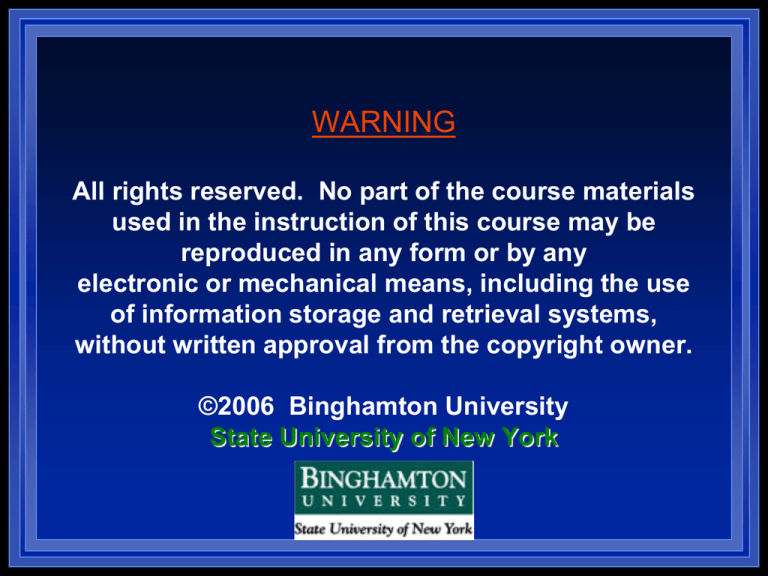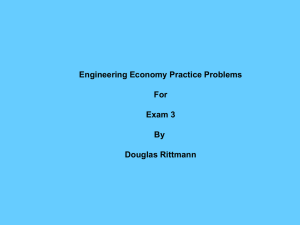
WARNING
All rights reserved. No part of the course materials
used in the instruction of this course may be
reproduced in any form or by any
electronic or mechanical means, including the use
of information storage and retrieval systems,
without written approval from the copyright owner.
©2006 Binghamton University
State University of New York
ISE 211
Engineering Economy
Chapter Four
Spreadsheets for Economic
Analysis
Chapter 5 >> Present Worth
Analysis
Application of Spreadsheets in Engineering Economy
Constructing
Tables of cash flows
Using annuity functions to calculate P, F, A, N, or i.
Using a block function to find present worth or
internal rate of return for a table of cash flows.
Making graphs for analysis and convincing
presentation.
Calculating “what if” for different assumed values of
problem variables
Spreadsheets Annuity Functions
To find the equivalent P
-PV(i,N,A,F,Type)
To find the equivalent A
-PMT(i,N,P,F,Type)
To find the equivalent F
-FV(i,N,A,P,Type)
To find N
NPER(i,A,P,F,Type)
To find i
RATE(N,A,P,F,Type, guess)
Spreadsheets Annuity Functions (cont’d)
Type =
0 or ommited
1
If payments are due
at the end of the period
at the beginning of the period
Guess is your guess for what the rate will be.
If you omit guess, it is assumed to be 10%.
If RATE does not converge, try different values for
guess. RATE usually converges if guess is between 0
and 1.
Example 1
A new engineer wants to save money for
down payment on a house. The initial
deposit is $685, and $375 is deposited at
the end of each month. The savings
account earns at an annual nominal rate
of 6% with monthly compounding. How
much is on deposit after 48 months?
Example 2
A new engineer buys a car with 0%
down financing from the dealer. The
cost with all taxes, registration, and
license fee is $15,732. If each of the 48
monthly payments is $398, what is the
monthly interest rate?
Spreadsheet Block Functions
Cash flows can be specified period-by-period as a block of
values.
These cash flows are analyzed by block functions that
identify the row or column entries for which a present worth
or an internal rate of return should be calculated.
Economic Criteria
Net present value
Internal rate of return
Excel Function
NPV(i,values)
IRR(values,guess)
Values for periods
1 to N
0 to N
Note: The cash flows for 1 to N are assumed to be end-of-
periods flows.
Example 1
Consider the following cash flow at 8% interest rate.
12,000
10,000
8,000
6,000
1
2
3
4
$2,500
a) Calculate the present worth value.
b) Calculate the internal rate of return.
Example 2
Graph the loan payment as a function of the
number of payments for a possible new car
loan. Let the number of monthly payments
vary between 36 to 60. The nominal annual
interest rate is 12%, and the amount
borrowed is $18,000.
Exercises (Chapter # 4)
4.125
4.127
4.129
4.135
Project Assignment #1
Problems
4.130 & 4.135 (using Excel).
Due via email:
Excel File Format: PA01_LastName.xls.
Problems should only be solved using spreadsheet
functions as discussed at the end of Chapter 4
(or lecture notes).
Chapter 5
Present Worth
Analysis
Economic Criteria
Situation
For Fixed Input
For Fixed Output
Neither Input nor Output Fixed
Therefore,
Criterion
Maximize Ouput
Minimize Input
Maximize (output-input)
we will examine ways to resolve
engineering problems, so that criteria for
economic efficiency can be applied.
Economic Criteria (cont’d)
Now we know how to convert a series of cash flows to
another form that is desired.
What form do we want to compare mutually exclusive
alternatives?
Chapter 5 -- Compare Present Worths
Chapter 6 – Compare equivalent Uniform Annual cash
flow
Chapter 7 – Figure out what interest rate allows benefits
to be bigger than costs
Applying Present Worth Techniques
Applying Present Worth Techniques (cont’d)
Present Worth Analysis is used to determine the present
worth value of future money receipts and disbursements.
Choose the option with the “Best” Present Worth.
There are three different analysis-period situations that are
encountered in economic analysis problems:
1) The “useful life” of each alternatives equals the analysis
period
2) The alternatives have useful lives different from the
analysis period
3) There is an infinite analysis period, n = .
1) Useful Lives Equal the Analysis Period
Example 1: A firm is considering which of two
mechanical devices to install to reduce costs in a
particular situation. Both devices cost $1000 and have
useful lives of five years and no salvage value. Device A
can be expected to result in $300 savings annually.
Device B will provide cost savings of $400 the first year
but will decline $50 annually, making the second year
savings $350, the third year savings $300, and so forth.
With interest at 7%, which device should the firm
purchase?
Example 2
Wayne County will build an aqueduct to bring water in
from the upper part of the state. It can be built at a
reduced size now for $300 million and be enlarged 25
years hence for an additional $350 million. An
alternative is to construct the full-sized aqueduct now for
$400 million. Both alternatives would provide the
needed capacity for the 50-year analysis period.
Maintenance costs are small and may be ignored. At 6%
interest, which alternative should be selected?
Example 3
A purchasing agent is considering the purchase of some new
equipment for the mailroom. Two different manufacturers
have provided quotations. An analysis of the quotations
indicates the following:
Manufacturer
Speedy
Allied
Cost
$1,500
1600
Useful life (years)
5
5
End-of-useful-life salvage value
$200
325
The equipment of both manufacturers is expected to perform
at the desired level of (fixed) output. For a five-year analysis
period, which manufacturer’s equipment should be selected?
Assume 7% interest and equal maintenance costs.
Example 4
A firm is trying to decide which of two alternate
weighing scales it should install to check a package
filling operation in the plant. The scale would allow
better control of the filling operation and result in
less overfilling. If both scales have lives equal to the
six-year analysis period, which one should be
considered? Assume 8% interest rate.
Alternate
Cost Uniform Annual Salvage Value
Benefit
$$$
Atlas Scale > $2000
$450
$100
Tom Thumb> $3000
$600
$700
2) Useful Lives Different from the Analysis Period
Example 1: Consider
the previous example 3.
Which alternative is best?
Manufacturer
Cost ($)
Useful life
(years)
End-of-useful life salvage
value ($)
Speedy
1500
5
200
Allied
1600
10
325
What if one item lasts 11 yrs and the other lasts 13 years?
Use
the least common multiple.
It seems unrealistic to use this as the analysis period,
so use the situation to decide on an appropriate
period.
Example, use __________, and assign some
terminal value to each alternative at the end of
____________.
You will be exposed to this kind of problems in the
homework.
3) Infinite Analysis Period – Capitalized Cost
Some projects need to be maintained permanently (forever):
roads, dams, graves, pipelines.
This particular analysis is called Capitalized Cost.
Capitalized Cost is the present amount of money required to be
invested at some interest rate to provide the service (or whatever)
for the project forever (indefinitely).
In this situation, you use the interest each year to pay for the
project, so you need to maintain the principal amount in the bank.
The cost each year is assumed to be the same – so each year we
withdraw A.
Illustration
End of
Year
1
2
3
.
546
Principal Interest
Earned
Withdraw
Example 1
You need $50/year for your grave
maintenance after you die. If you
earn 4%, how much do you need to
set aside by one year before you die?
Example 2
A city plans a pipeline to transport water
from a distant watershed area to the city.
The pipeline will cost $8 million and have
an expected life of seventy years. The city
anticipates it will need to keep the water
line in service indefinitely. Compute the
capitalized cost assuming 7% interest.
Assumptions in Econ Analysis
1) End of year conventions
Remember tables and formulas assume cash flow at the
end of the period
Spreadsheets can handle cash flows at beginning or end of
period – but be careful!
2) Use the viewpoint of the whole company / large entity – like
shipping department VS entire company.
3) Sunk costs – ignore them!
4) Borrowed Money
We assume that money spent in the problems is borrowed
at the same rate and conditions given in the problem.
Assumptions in Econ Analysis (cont’d)
5) Effect
of Inflation and Deflation
For now, assume no inflation or deflation –
prices are stable
6) Income Taxes
For now, no income taxes effects/consequences
Multiple Alternatives
For more than two alternatives, just get all the present worth values and choose
the best alternative for your situation.
Example 1: A contractor has been awarded the contract to construct a six-miles-long
tunnel in the mountains. During the five-year construction period, the contractor will need
water from a nearby stream. He will construct a pipeline to convey the water to the main
construction yard. An analysis of costs for various pipe sizes is as follows:
Installed cost of pipeline and pump
Cost per hour for pumping
2"
$22,000
$1.20
Pipe Size
3"
4"
$23,000
$25,000
$0.65
$0.50
6"
$30,000
$0.40
The pipe and pump will have a salvage value at the end of five years equal to the cost to
remove them. The pump will operate 2000 hours per year. The lowest interest rate at
which the contractor is willing to invest money is 7%. (The minimum required interest
rate for invested money is called the Minimum Attractive Rate of Return, MARR).
Select the alternative with the least present worth of cost.
Example 2
An investor paid $8,000 to a consulting firm to analyze what
he might do with a small parcel of land on the edge of town
that can be bought for $30,000. In their report, the consultants
suggested four alternatives. Assuming 10% is the minimum
attractive rate of return, what should the investor do?
Alternatives
A. Do nothing
B. Vegetable Market
C. Gas Station
D. Small motel
Total Investment including land ($)
0
$
50,000
$
95,000
$
35,000
Uniform net Annual benefit ($)
0
$
5,100
$
10,500
$
36,000
Terminal value at the end of 20 yr ($)
0
$
30,000.00
$
30,000.00
$
15,000.00
Example 3
A piece of land may be purchased for $610,000 to be
strip-mined for the underlying coal. Annual net
income will be $200,000 per year for ten years. At the
end of the ten years, the surface of the land will be
restored as required by a federal law on strip mining.
The cost of reclamation will be $1,500,000 more than
the resale value of the land after it is restored. Using
a 10% interest rate, determine whether the project is
desirable.
Example 4
Two pieces of construction equipment are being
analyzed. Based on an 8% interest rate, which
alternative should be selected?
Year
0
1
2
3
4
5
6
7
8
Alternative A
-$2,000
$1,000
$850
$700
$550
$400
$400
$400
$400
Alternative B
-$1,500
$700
$300
$300
$300
$300
$400
$500
$600
Using Spreadsheets
Example 1: NLE
Construction is bidding on
a project whose costs are divided into
$30,000 for startup and 12 equal payments
of $20,000 at the end of each month. If the
annual interest rate is 12.5%, compounded
monthly, what is the present worth?
Using Spreadsheets (cont’d)
Example 2: Regina Industries has a new product
whose sales are expected to be 1.2, 3.5, 7, 5, and 3
million units per year over the next 5 years.
Production, distribution, and overhead costs are
stable at $120 per unit. The price will be $200 per
unit for the first 2 years, and then $180, $160, and
$140 for the next 3 years. The R&D costs are $400
million. If the annual interest rate is 15%, what is the
present worth of the new product?
Homework # 05 (Chapter # 5)
4
9
10
11
16
20
48
52
54
63
67
68
71









